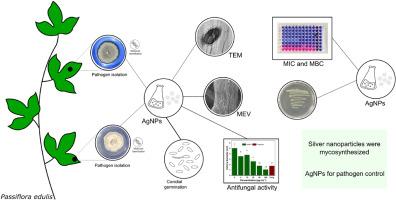纳米银纳米颗粒防治西番莲作物叶面病原菌的研究
IF 3.8
Q2 BIOTECHNOLOGY & APPLIED MICROBIOLOGY
引用次数: 0
摘要
植物病原体的可持续管理推动了金属纳米颗粒的使用,因为它们具有高抗菌功效、稳定性和环境兼容性。在这项工作中,我们研究了真菌合成的银纳米粒子对黄色西番莲(Passiflora edulis)病原体的抗菌作用。病原菌选择包括野外取样、分离和再感染试验,确认了枝孢杆菌和可可炭疽杆菌的存在。并对轴索黄单胞菌进行了研究。passiflorae。以巴西曲霉内生提取物为原料合成AgNPs,羧甲基纤维素共稳定AgNPs,并通过结构、形态和界面技术对其进行了表征,发现AgNPs的直径为18.78 nm, zeta电位为- 23.41 mV。体外实验表明,AgNPs对枝孢霉和可可霉菌丝生长具有抑制作用,且呈剂量依赖性,60 ~ 100 μg mL−1的抑制作用可达80%以上。浓度大于20 μg mL−1可有效抑制分生孢子萌发。电镜观察发现菌丝和细胞壁结构损伤。对于轴索黄单胞菌pv。最小抑菌浓度(MIC)为20 μg mL−1,最小杀菌浓度(MBC)为60 μg mL−1。这些结果强调了真菌合成纳米颗粒作为抗菌药物的潜力,为百香果疾病的管理提供了一个有希望的替代方案。体外研究的重要性也被强调为一种在受控条件下理解纳米颗粒作用的方法,允许候选物的预选和边界条件的定义,改进体内实验的设计。本文章由计算机程序翻译,如有差异,请以英文原文为准。

Silver nanoparticles for control of foliar pathogens in passion fruit (Passiflora edulis) crops
Sustainable management of phytopathogens has driven the use of metallic nanoparticles due to their high antimicrobial efficacy, stability and environmental compatibility. In this work, we investigate the antimicrobial action of silver nanoparticles mycosynthesized against pathogens of yellow passion fruits (Passiflora edulis). Pathogen selection involved field sampling, isolation, and reinfection assays, confirming the presence of Cladosporium cladosporioides and Colletotrichum theobromicola. as well as investigated the bacterium Xanthomonas axonopodis pv. passiflorae. The AgNPs were mycosynthesized using the endophytic extract of Aspergillus brasiliensis and co-stabilized by carboxymethyl cellulose, and characterized by structural, morphological and interfaces techniques, exhibiting important physicochemical characteristics as diameter of 18.78 nm, and zeta potential of −23.41 mV. The in vitro assays demonstrated the inhibitory effect of AgNPs for mycelial growth of C. cladosporioides and C. theobromicola, with dose-dependent response, reaching inhibition exceeding 80 % for 60–100 μg mL−1. Concentrations above 20 μg mL−1 effectively inhibited the conidial germination. Electron microscopies revealed structural damage to hyphae and cell wall fungi. For Xanthomonas axonopodis pv. passiflorae, the minimum inhibitory concentration (MIC) was 20 μg mL−1, and the minimum bactericidal concentration (MBC) was 60 μg mL−1. These results underscore the potential of mycosynthesized nanoparticles as antimicrobial agents, presenting a promising alternative for the management of passion fruit diseases. The importance of in vitro studies is also highlighted as a methodology for understanding the action of nanoparticles under controlled conditions, allowing the pre-selection of candidates and the definition of boundary conditions, improving the design of in vivo experiments.
求助全文
通过发布文献求助,成功后即可免费获取论文全文。
去求助
来源期刊

Biocatalysis and agricultural biotechnology
Agricultural and Biological Sciences-Agronomy and Crop Science
CiteScore
7.70
自引率
2.50%
发文量
308
审稿时长
48 days
期刊介绍:
Biocatalysis and Agricultural Biotechnology is the official journal of the International Society of Biocatalysis and Agricultural Biotechnology (ISBAB). The journal publishes high quality articles especially in the science and technology of biocatalysis, bioprocesses, agricultural biotechnology, biomedical biotechnology, and, if appropriate, from other related areas of biotechnology. The journal will publish peer-reviewed basic and applied research papers, authoritative reviews, and feature articles. The scope of the journal encompasses the research, industrial, and commercial aspects of biotechnology, including the areas of: biocatalysis; bioprocesses; food and agriculture; genetic engineering; molecular biology; healthcare and pharmaceuticals; biofuels; genomics; nanotechnology; environment and biodiversity; and bioremediation.
 求助内容:
求助内容: 应助结果提醒方式:
应助结果提醒方式:


